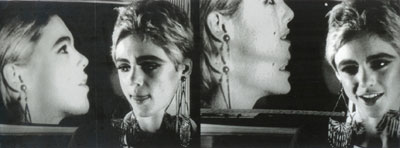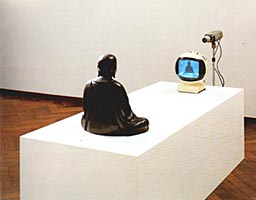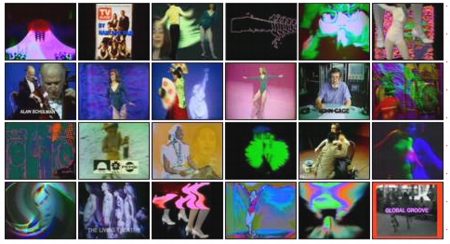While is ridiculously easy to soak in Derek Jarman’s work in the UK at the moment, it’s nigh impossible to find anything programmed in the US. Fortunately, one of Jarman’s most easily accessible bodies of work–music videos–is also one of his most readily available. For some reason, it’s also one of his least recognized critically. [I hope someone will prove me wrong by sending links or references to a nice article or exhibition of Jarman’s music videos.]
Cross referencing the incomplete list on Wikipedia with the partially obscured filmography in Rowland Wymer’s 2005 critical essays collection, Derek Jarman, I think I’ve come up with a complete list. Then I searched them out on YouTube. Everyone knows The Smiths and the Pet Shop Boys, but did you know Jarman directed the video for Wang Chung’s “Dance Hall Days”?
Category: inspiration
Clean Flix In The Front, Underage Porn Party In The Back
Daniel Thompson, the guy behind Clean Flix, [1], Flix Club, an Orem, Utah video store that, like Clean Flicks before it, edited sex, nudity, and swearing scenes from Hollywood movies, has been arrested for paying for sex with 14-year-old girls.
One of the girls’ moms found the $20 bill and asked where it had come from.
The booking documents state Thompson told the 14-year-olds that his film sanitizing business was a cover for a pornography studio. He asked the girls if they would participate in making a porn movie, but they refused, the documents state.
Police found a “large quantity” of pornographic movies inside the business, along with a keg of beer, painkillers and two cameras hooked up to a television. Thompson told police he didn’t know the teenagers were under 18 or that they were paid for sex. He said pornography found at the business was for “personal use,” according to the documents.
Reminds me of the hypocritical conservative zealot who was outraged at the occasional nudity in the foreign films shown at BYU’s International Cinema program. He demanded that he be allowed to screen and edit out all the smut himself.
[1] update: oh wait, the place is just some me-too outfit called Flix Club, not the original Clean Flicks. I thought 31 was too young to have been starting businesses based on the single nude scene in Titanic.
update update: alright, Clean Flicks connection re-established. The Provo Daily Herald explains that Thompson was a Clean Flicks dealer until that company went out of business. Then he re-opened under the new Flix Club name, until he was closed down last year in a separate court ruling.
Former sanitizer of rental movies is accused of paying teens for sex [sltrib via thr]
Clean-film business was front for porn, police say [heraldextra.com]
Previously: nude scenes at BYU
It’s A Small Warhol’s World
I’m still looking around for anyone who gave an account of yesterday’s discussion of Warhol films at the American Museum of the Moving Image. Warhol Film Project director Callie Angell and film critic Amy Taubin were supposed to “discuss the artistic significance of Warhol’s films, the social and cultural milieu surrounding their production, and the history of their reception and their restoration.”
If you see something, please say something.

still from Inner and Outer Space, 1965
And as for the AMMI’s ongoing Warhol’s World film screening series, you should definitely see something. There are several reels of Screen Tests being shown. On Nov. 3rd, Saturday afternoon, a new print of Outer and Inner Space, the innovative double image, video-on-film portrait of Edie Sedgwick is screening. After that is a new print of Chelsea Girls. And the next week, Nov. 11th, is a new print of Lonesome Cowboys, which stars–among other people–Allen Midgette, the actor who pretended to be Andy during a 1967 speaking tour of western university campuses.
Warhol’s World – Screenings & Events, through Nov. 11th [movingimage.us]
Previously:
Have you seen me? Warhol’s lost videos
The Fake Warhol Lectures
John Cage’s Chess Pieces

I’ve been listening to WNYC’s anniversary tribute programming for John Cage, and it’s really great [if a bit over-narrated; I mean, who’s going to listen to 24h33m of John Cage programming on-demand who isn’t at least somewhat familiar with his work already?]
One 1944 composition, Chess Pieces, was only rediscovered and played for the first time in 2005.
Cage had been invited to participate in a chess-themed exhibit at the Julian Levy Gallery organized by Max Ernst and Marcel Duchamp, and he created a chessboard-sized painting with fragments of musical scores in each of the squares. Each square held about twelve measures in three rows. The painting went into a private collection where it remains, almost completely invisible to the outside Cageian world until 2005, when the Noguchi Museum recreated the 1944 exhibit, “The Imagery of Chess.” [Noguchi had contributed a chess set to the show, as did artists such as Man Ray and Alexander Calder.]
Anyway, Cage pianist Margaret Leng Tan was commissioned to transcribe and perform the score in the painting, which premiered alongside the 2005 exhibit. The DVD of the Chess Pieces performance includes several other Cage sonatas and some short-sounding documentaries, including one about the history of the work. Not sure what that means.
As a painting, the collaged, juxtaposed chaos of the notes contrasts with the order of the grid. It kind of reminds me of the cut-up technique William Burroughs and the Beats’ applied to books and printed texts a few years later. [The history of cut-up mentions an interesting, even earlier reference: Dada pioneer Tristan Tzara, who was expelled from Breton’s Surrealist movement when he tried to create poetry by pulling words out of a hat.]
As a musical composition, Chess Pieces is nice, old-school Cage, abstract and occasionally abrupt, but with a still-traditional piano feel. Since the piece’s randomness comes from its structure–the distribution of the notational fragments across the grid–and not from the performer’s own decisions, it somehow has a “composed” feeling to it. So though it’s new to audiences today, it’s also classic, early Cage.
“Thanks For All The Memories/ Alright, Let’s See Your Arm”
Seeing William Burrough’s old Nike commercial reminded me of Burroughs’ 1996 music video Thanksgiving Prayer, directed by Gus Van Sant. Classic stuff.
If I Were Jean-Luc Godard, I’d Stop Jaywalking, Pronto
today: Michelangelo Antonioni, 94, Italian Director, Dies [ap/nyt]
yesterday: Ingmar Bergman, Master Filmmaker, Dies at 89 [nyt]
Sorry, we got cut off. You were saying?
From Theresa’s blog, The Wit of the Staircase:
From the French phrase ‘esprit d’escalier,’ literally, it means ‘the wit of the staircase’, and usually refers to the perfect witty response you think up after the conversation or argument is ended. “Esprit d’escalier,” she replied. “Esprit d’escalier. The answer you cannot make, the pattern you cannot complete till aterwards it suddenly comes to you when it is too late.”
But what if you didn’t know it was too late? What if you’re right in the middle of the conversation? What’s it called then?
John Cage Performing Live
This is awesome. John Cage performing “Water Walk,” live on the 1960 TV quiz show, I’ve Got A Secret.
John Cage performing “Water Walk” [youtube]
John Cage on a TV Game Show in 1960 (video) [WFMU’s awesome blog, with downloadable video, too, via Stuck Between Stations]
Antonioni’s Chung Kuo
So I’m researching camera angles for an article I’m writing, and so I break out the trusty Susan Sontag, On Photography, and I finally get to the last essay/chapter, which I guess I’ve never read.
It’s the one where she talks about Michelangelo Antonioni’s Chung Kuo – Cina, his 1972 documentary gift from Italy to the PRC–which promptly got caught up in China’s internal party battle between Mao’s wife and Zhou Enlai, and was massively denounced as a vicious pack of anti-China propaganda. [The Party had approved and supervised/surveilled the 8-week shooting, and Antonioni deployed secret cameras at various points to shoot un-preapproved crowd shots.]
As evidence, the Communist-controlled news media published an analysis/critique of Antonioni’s editing techniques, his subjects–and his camera placement:
And he was accused of denigrating the right subjects by his way of photographing them: by using “dim and dreary colors” and hiding people in “dark shadows”; by treating the same subject with a variety of shots — “there are sometimes long-shots, sometimes close-ups, sometimes from the front, and sometimes from behind” — that is, for not showing things from the point of view of a single, ideally placed observer; by using high and low angles — “The camera was intentionally turned on this magnificent modern bridge from very bad angles in order to make it appear crooked and tottering”; and by not taking enough full shots — “He racked his brain to get such close-ups in an attempt to distort the people’s image and uglify their spiritual outlook.”
Now I’m fascinated. The film–and subsequently, all Antonioni’s work–was banned in China, and was only shown for the first time in 2004. It caused a diplomatic scene at the Venice Film Festival in 1974 when it was set to be screened at La Fenice.
I’m trying to download a torrent of it right now, but otherwise, it’s so hard to find, you might as well be in China. The only thing on the YouTube, appropriately enough, is a five-min segment of comrades lining up to have their photos taken in Tianenmen Square.
ESWN has excerpts of Umberto Eco and Sontag discussing the film’s Chinese reaction [via archive.org, found via supernaut]
Google trans. of clip’s narration/subtitles [fuluzhenxiang]
Proof of Concept: Il Heliostat di Viganella
The idea to use a large heliostat to deliver winter sunlight to a small village deep in a valley of the Italian Alps, was a success:
The mirror — 870 meters, or 2,900 feet, above Viganella and measuring 8 meters wide by 5 meters high — is motorized and constantly tracks the sun. Computer software tilts and turns the panels throughout the daylight hours to deflect the rays downward. But from Viganella’s main square, bathed in reflected sunlight, all that is visible of the false sun is a bright glare from the slope above.
“At first no one believed it could be possible, but I was certain. I have faith in physics,” said Giacomo Bonzani, an architect and sundial designer who came up with the idea of reflecting sunlight onto the square and made the necessary astronomical calculations. The project languished for a few years until funding — about €100,000, or $130,000 — came through last year from private and public sponsors.
The mirror was designed by Emilio Barlocco, an engineer whose company specializes in using reflected sunlight to light the entrances to highway tunnels. He read about Viganella’s plight on the front page of the Turin daily La Stampa and offered the village his expertise and services. “Whenever you do something for the first time, you’re either a pioneer or stupid,” he said. “We hope we’re the former.”
A concrete plinth was anchored to the rock face of the slope above Viganella to serve as the mirror’s base. The mirror panels were flown up by helicopter. The software that tracks the sun’s rotation is so sophisticated that the rays can be directed anywhere by the computer, which is in the town hall. “If the church or the bar in the town next door has an event, like a baptism, or a wedding, we can shoot the rays there,” Midali said. “It’s very versatile.”
When I first thought up a project to do this in 1999, even when I started talking to Olafur about it in 2003-4, I didn’t even know I was talking about a heliostat. But now with the Wikipedia, and the advent of the Solar Positioning Algorithm and the more comprehensive libnova celestial mechanics library–and the successful testing in Viganella, of course–my excuses for not building me one of these are rapidly diminishing.
Computer age brings sun to village in shadow of the Alps [iht via tmn]
Previously: On an Unrealized Art Project
Nam June Paik’s Early Work

I used to live downstairs from Nam June Paik. I was too starstruck to ever talk with him at length, but we had friendly chats when we’d see each other in the stairway of our Little Italy loft building.
Once, I did manage to tell him how much I admired his pieces in the John Cage show that was going on over at the Guggenheim SoHo [“Rolywholyover: A Circus,” still one of the most brilliant and exciting museum exhibitions I’ve ever seen. Incredible catalogue, too.] My favorite was and is TV Buddha, a nearly perfect conceptualized work comprised of a carved Buddha statue , a video camera, and a television. The statue sits enlightened and silent, endlessly watching itself on the screen.
TV Buddha is made even better by the allegedly offhand way it was created, as “wall filler” for a 1974 gallery show in New York, though I wouldn’t be surprised if Paik was just being reflexively modest when the work was praised.
He made many versions and variations on the TV Buddha theme over the years, and I’d also imagine it could come to feel like a zen trap, a polite rut, especially for an artist whose work betrays an abiding affection for baroque dadaism and psychedelic media cacophony. TV Buddha feels like a kind of contemplative road less traveled.

The road Paik took instead, was the one he named, the Information Super-Highway, which was signalled by another seminal early piece, the 1973 TV show/control room happening/video art work, Global Groove. Produced with John Godfrey at WNET in New York, Global Groove is at once freakishly prescient and contemporary, and hilariously of its time.
It opens with the bold promise that we’re living with right now: “This is a glimpse of the video landscape of tomorrow, when you will be able to switch to any TV station on the earth, and TV Guide will be as fat as the Manhattan telephone book.” Which is promptly followed by a groove challenged pair of disco dancers and every psychedelic FX trick in the 1973 TV producer’s book. It’s at once funny and sad to realize Global Groove‘s aesthetic has become the lingua franca of Manhattan’s public access TV world. Hell, it’s probably the same mixing board Paik & Godfrey used.
Paik’s TV sculptures and giant video walls which are so popular/populist with museums and lobby decorators feel like continuations of Global Groove‘s groove, but it doesn’t scale. Paik foresaw our TV-webby mediascape and reveled in it; I just wish and wonder if somewhere in Paik’s mature-to-late career, away from the bombastic over-commissions, there’s some underappreciated body of work that might enlighten us as to how we can live in this worldwide web.
See a photo of the first TV Buddha and watch the first few minutes of Global Groove on Mediakunstnetz.de [mkz]
There’s some Paik-related material on YouTube, but not as much as you’d hope [youtube]
On Robert Altman
After memorizing The Player, the visceral Short Cuts got me hugely excited for Pret a Porter. Oops. At the time, I had to learn for myself what Pauline Kael knew long ago: she “joked about his fertile seventies output that every other film was a masterpiece and that she wished she could skip the ones in between.”
The quote’s from David Edelstein’s remembrance of Altman for NYMag. It’s worth a read. [nymag]
Meanwhile, Tony Scott reminds me that that incredible Lily Tomlin-Meryl Streep schtick at the Oscars last spring was exactly the kind of offhand-yet-impossible tour de acting force Altman was able to capture. or coax. or catalyze in his films. [nyt]
And then there’s a real leaping off point. David at GreenCine points back to Matthew Zoller Seitz’s Altman Blogathon Weekend last March, in anticipation of the long overdue Altman Oscars.
Theresa Duncan’s own remembrance of McCabe and Mrs. Miller is awesome, especially the anecdote at the end about Leonard Cohen finally coming around to liking the film that he reluctantly licensed his music to.
“One Bank”: From Ethan Chandler’s Greatest Hits
Even when I worked for The Mouse, I cringed and laughed at the pile-up mash-ups of corporate life and pop culture. On the rarest occasions, like with Atomic Revolution, the nuclear propaganda comic book produced by adman M. Philip Copp for his Connecticut yacht club buddies at General Dynamics can actually be a powerful, if overlooked work of art. Mostly, they’re kitschy train wrecks, though, like the commissioned corporate musicals and company anthems for the likes of KPMG.

Because the genre’s signal-to-noise ratio is so low, I avoided watching “One Bank,” the video making the rounds this week where some Bank of America execs turned U2’s “One Love” into a celebration of BofA’s merger with credit card giant MBNA. Known quantity, I figured.
[Forget for a moment that uncompromising rock artists–Bono included–have been dogpiling onto the corporate moneywagon for years now. Suggs and his mates from Madness, for example, know better than to show their sellout faces around my house after allowing Maxwell House frickin’ Coffee to desecrate the anthem of my youth.]
But Andy‘s description, “painful to watch in its sincerity,” lured me in. [He really is a master of the <10 word write-up.] It's really amazing to watch, precisely because of the balls-out sincerity. That, and the dude's not actually a bad singer; sincerity you can fake, but the guy has chops.
I decided the appropriately bemused thing to do was to keep my eye out for him at BofA locations in Manhattan, and when I saw him stepping out for a smoke, I'd give him the "Are you Ethan Chandler??!” high five that a true Internet celebrity deserves.
But a quick Google search flipped my telescope around completely. Turns out the guy had some songs and and an EP published by EMI in the 1990’s; he fronted a cover band that played gigs around the Northeast; and he put out a CD in 2002. Ethan Chandler isn’t a banker who thinks he’s a musician; he’s a musician whose dayjob is in a bank.
As a finance industry survivor who’s wrestled for years with how to balance making a living and pursuing a passion, I’ve gotta give Chandler props for trying to bridge his two seemingly incompatible worlds. If you see Chandler at the bank, meanwhile, give him a high five for me.
Buy Ethan Chandler’s presciently titled 2002 CD, “Better Days Ahead” [awarestore.com]
Have Yourself A Maysles Little Christmas
As I type this, the Maysles Brothers classic Grey Gardens is playing at MoMA. Unfortunately, I’m in the wrong time zone to see it, but watching those Crazy Edies suddenly seems like an excellent Christmas Eve tradition.
Meanwhile, I will be back in time for what would have been an awesome triple feature, if only they weren’t overlapping: sandwiched between the Maysles’s incredible documentary, Salesman [a business school in-class screening of which, for better or worse, set me on my filmmaking path] and Albert’s docu about the making of the Getty Center [worth watching just to see Richard Meier get so pissed at Robert Irwin] is Gus Van Sant’s Elephant, which was programmed, surprisingly, by Stephen Sondheim.
Merry Christmas to all who celebrate it, and to the rest of you, enjoy your Chinese food.
MoMA Film & Media screening schedule 16-31 Dec 2005 [moma.org]
John Cage On WPS1 (And On Their Blogs)
For the 1993 Venice Biennale, PS1 produced an exhibition of and about John Cage’s work calledIl Suono rapido delle cose. This week, WPS1 has added a webcast of the accompanying CD to their archive. The CD features performances by Lee Ranaldo, John Zorn, David Byrne, Joey Ramone, among many others, interspersed among Cage reading his own stuff. Definitely worth checking out. [warning: don’t expect any babies to sleep through Ranaldo’s jarring chords.]
Meanwhile, the Cageian embrace of randomness is alive and well on WPS1’s blogs [who knew?]. It seems there are 13 feeds-in-one, although not all have been kept up to date. Upbeat updates from one blogger’s happy Scandinavian/Los Angeleno curatorial collaboration called Civic Matters are interlaced with another blogger/dj’s virtual spitting on Rehnquist’s grave. It may be a perfect embodiment of the WTF-chaos that gives PS1 its edge.
